Envision Math Grade 8 Volume 1 Chapter 1: Real Number
Page 73 Question 1 Answer
- A real number would be any number that can be discovered in the actual world. Numbers can be found all around us.
- Natural numbers are being used to count objects.
- Rational numbers are being used to portray fractions.
- Irrational numbers are being used to calculate the square root of an amount.
- Integers are used to measure temperature, among other things.
- These various types of numbers combine to form a gathering of real numbers.
- Except for complex numbers, everything comes under real numbers.
- It is denoted by R and it is the union of both rational and irrational numbers and it is represented by \(R=Q \cup \bar{Q}\)
- Real numbers are used in many places to solve problems. For example, it is used to portray fractions, determine square roots, measure temperature, and for counting things etc.
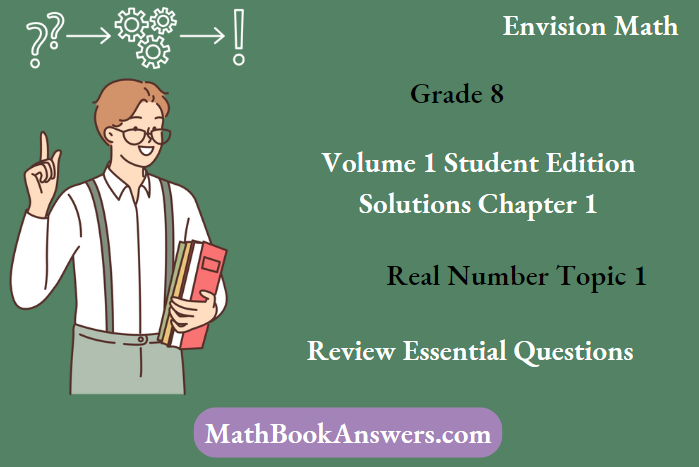
Envisionmath 2.0 Grade 8 Chapter 1 Real Number Solutions
Envision Math Grade 8 Volume 1 Student Edition Answers Chapter 1 Real Number Topic 1 Page 73 Exercise 1 Answer
- We have to draw lines to connect each vocabulary word with its definition.
- Cube root is nothing but a number whose cube equals the original number.
- For example, The cube root of \(\sqrt[3]{64} \text { is } 4\).
- Square root is nothing but a number whose square equals the original number.
- Example – The square root of \(\sqrt{16} \text { is } 4\)
- A perfect cube is a number that is the result of multiplying the number three times by itself.
- Example – The cube of 5 is 125
- A perfect square is a number that is the result of multiplying the number two times by itself.
- Example – The square of 5 is 25
- Scientific is a way of expressing very big or very small numbers in compact form.
- Example – 3.5 ×1012 which is equal to 3500000000000
- Power of powers property states that when we have an exponent which is raised to a power, then we need to multiply those by keeping the bases same.
- Example – (42)3 = 42 × 3 = 46
- Power of products property states that when multiplying two powers with the same base, add the exponents by keeping the base same.
- Example – 25⋅210 = 25+10 = 215
- Product of powers property states that when multiplying two same exponents with the different bases, keep the exponents by multiplying the bases together.
- Example – 72 ⋅ 52 = (7 × 5)2 = 352
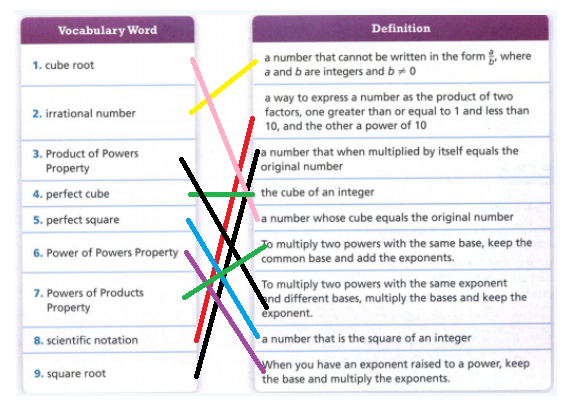
Envision Math Grade 8 Volume 1 Student Edition Answers Chapter 1 Real Number Topic 1 Page 73 Exercise 1 Answer
We need to use vocabulary words to explain how to find the length of each side of a square garden with an area of 196 square inches.
The area of the square garden is given by 196 square inches.

The length cannot be negative.
Thus, the length of each side of a square garden is 14 inches.
The length of each side of a square garden is 14 inches.
Envisionmath 2.0 Grade 8 Topic 1 Essential Questions Review Answers
Envision Math Grade 8 Volume 1 Student Edition Answers Chapter 1 Real Number Topic 1 Page 74 Exercise 2 Answer
- We need to write the given decimal \(0 . \overline{0} 4\) as a mixed number or fraction.
- A repeating decimal can be written as a fraction by assuming the decimal as a variable.
- After that, multiply each side of it by the multiples of 10
- Subtract both expressions to write the repeating decimals as fractions.
- The decimal is converted to fractions as,
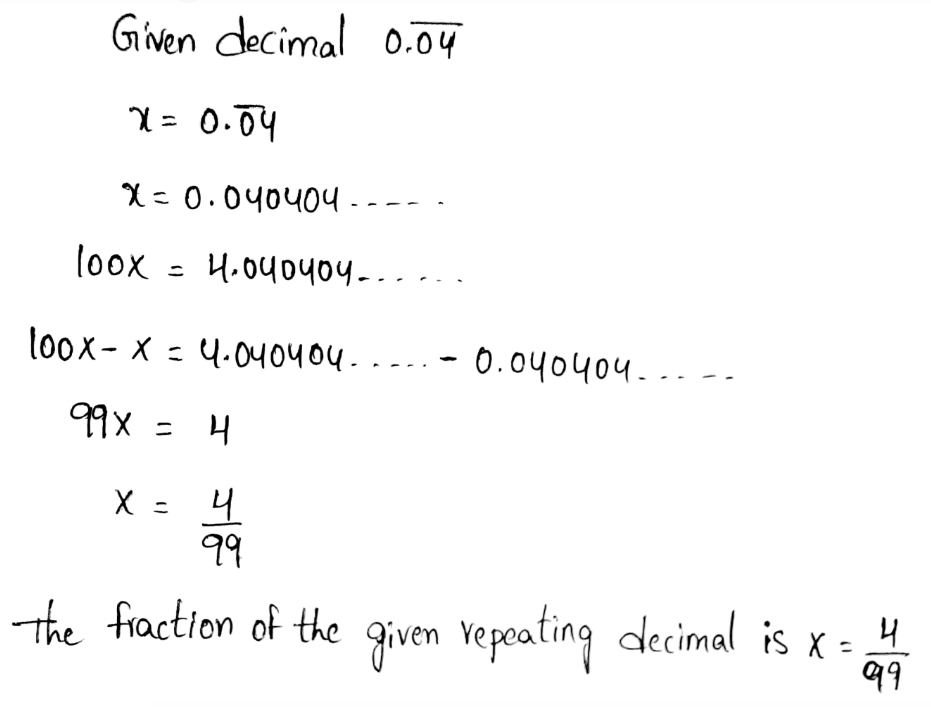
The fraction of the given repeating decimal is \(x=\frac{4}{99}\)
Envision Math Grade 8 Volume 1 Student Edition Answers Chapter 1 Real Number Topic 1 Page 74 Exercise 3 Answer
- We need to write the given decimal \(4 . \overline{45}\) as a mixed number or fraction.
- A repeating decimal can be written as a fraction by assuming the decimal as a variable.
- After that, multiply each side of it by the multiples of \(4 . \overline{45}\)
- Subtract both expressions to write the repeating decimals as fractions.
- The decimal is converted to a fraction as,

The mixed number of the given repeating decimal is \(x=4 \frac{45}{99}\)
Envision Math Grade 8 Volume 1 Student Edition Answers Chapter 1 Real Number Topic 1 Page 74 Exercise 4 Answer
We need to write the given decimal 2.191919… as a mixed number or fraction.
- A repeating decimal can be written as a fraction by assuming the decimal as a variable.
- After that, multiply each side of it by the multiples of 10
- Subtract both expressions to write the repeating decimals as fractions.
The decimal is converted to fractions as,
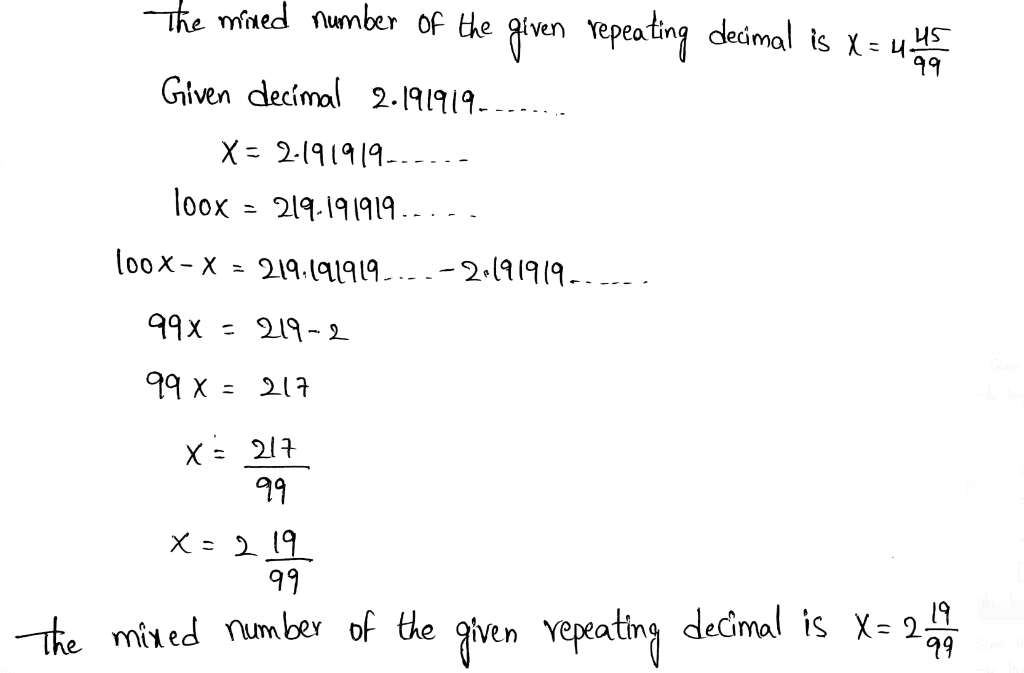
The mixed number of the given repeating decimal is \(x=2 \frac{19}{99}\)
Envision Math Grade 8 Volume 1 Student Edition Answers Chapter 1 Real Number Topic 1 Page 74 Exercise 1 Answer
We need to determine which numbers are irrational from among the given.
- Irrational numbers cannot be represented as a fraction.
- Irrational numbers are non-terminating and non-repeating in nature.
- Only terminating and repeating decimals can be represented as a fraction.
- Rational numbers are terminating and repeating in nature.
- Only rational numbers can be represented as a fraction while irrational numbers cannot.
Thus, evaluating the given numbers one by one, we get,
\(\sqrt{36}=6\)√23 = not a perfect square
\(-4.232323 \ldots=-4 . \overline{23}\)0.151551555… = non-repeting
\(0 . \overline{35}=\text { repeating }\)π = 3.14 = terminating
The irrational numbers are
(B) √23
(D) 0.151551555…
Envision Math Grade 8 Volume 1 Student Edition Answers Chapter 1 Real Number Topic 1 Page 74 Exercise 2 Answer
We need to explain the number \(-0 . \overline{25}\) is rational or irrational.
- Irrational numbers cannot be represented as a fraction.
- Irrational numbers are non-terminating and non-repeating in nature.
- Only terminating and repeating decimals can be represented as a fraction.
- Rational numbers are terminating and repeating in nature.
- Only rational numbers can be represented as a fraction while irrational numbers cannot.
The given number \(-0 . \overline{25}\) is repeating in nature.
Hence, it is a rational number.
The given number \(-0 . \overline{25}\) is a rational number.
Envision Math Grade 8 Volume 1 Student Edition Answers Chapter 1 Real Number Topic 1 Page 75 Exercise 1 Answer
We need to find between which two whole numbers does √89 lies.
- Finding where the given square root number lie in the number line, thus,
√81 < √89 < √100
9 < √89 < 10
The given number lies between the whole numbers 9 and 10
√89 is between 9 and 10.
Envision Math Grade 8 Volume 1 Student Edition Answers Chapter 1 Real Number Topic 1 Page 75 Exercise 2 Answer
We need to compare and order the following numbers. Locate each number on a number line.
- \(2 . \overline{3}, \sqrt{8}, 2.5,2 \frac{1}{4}\)
- The given numbers are \(2 . \overline{3}, \sqrt{8}, 2.5,2 \frac{1}{4}\)
Finding where the given square root number lie in the number line, thus,
√4 < √8 < √9
2 < √8 < 3
2.5 < √8 < 3
Since it is closer to 9 than 4
Also, \(2 \frac{1}{4}=\frac{9}{4}=2.25\)
Thus, the order becomes,
\(2 \frac{1}{4}<2 . \overline{3}<2.5<\sqrt{8}\)The order of the given numbers is \(2 \frac{1}{4}<2 . \overline{3}<2.5<\sqrt{8}\)

Solutions For Envisionmath 2.0 Grade 8 Volume 1 Chapter 1
Envision Math Grade 8 Volume 1 Student Edition Answers Chapter 1 Real Number Topic 1 Page 75 Exercise 1 Answer
We need to classify the number as a perfect square, a perfect cube, both, or neither. The given number is 27
For a number to be a perfect cube or a perfect square, the result of its cube root or its square root will be a whole number.

The given number is a perfect cube.
Envision Math Grade 8 Volume 1 Student Edition Answers Chapter 1 Real Number Topic 1 Page 75 Exercise 3 Answer
We need to classify the number as a perfect square, a perfect cube, both, or neither. The given number is 64
For a number to be a perfect cube or a perfect square, the result of its cube root or its square root will be a whole number.
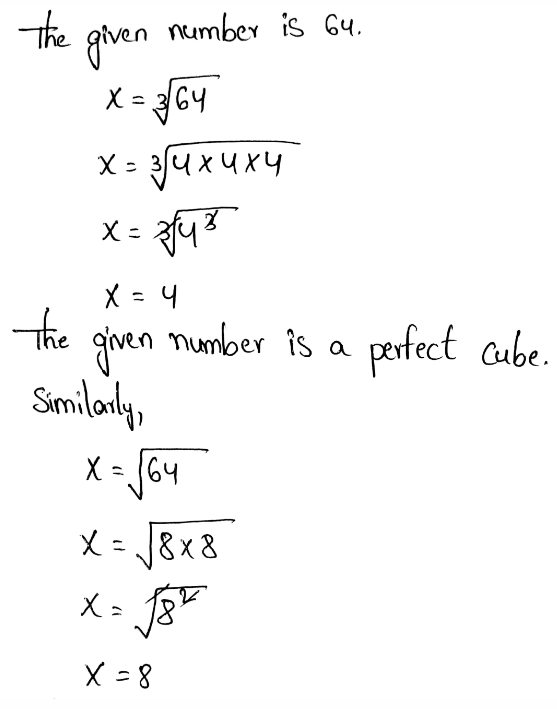
The given number is a perfect square.
The given number is both a perfect square and a perfect cube.
Envision Math Grade 8 Volume 1 Student Edition Answers Chapter 1 Real Number Topic 1 Page 75 Exercise 4 Answer
We need to classify the number as a perfect square, a perfect cube, both, or neither. The given number is 24
For a number to be a perfect cube or a perfect square, the result of its cube root or its square root will be a whole number.
Thus, determining the given number, we get,
\(x=\sqrt[3]{24}\)x = 2.88
The given number is not a perfect cube.
Similarly,
\(x=\sqrt{24}\)x = 4.89
The given number is not a perfect square.
The given number is neither a perfect square and a perfect cube.
Envision Math Grade 8 Volume 1 Student Edition Answers Chapter 1 Real Number Topic 1 Page 76 Exercise 2 Answer
We need to solve x2 = 49
Solving the given expression, we get,

The value of x = +7 and x = −7
Envisionmath 2.0 Grade 8 Chapter 1 Real Number Step-By-Step Solutions
Envision Math Grade 8 Volume 1 Student Edition Answers Chapter 1 Real Number Topic 1 Page 76 Exercise 3 Answer
We need to solve x3 = 25
Solving the given expression, we get,
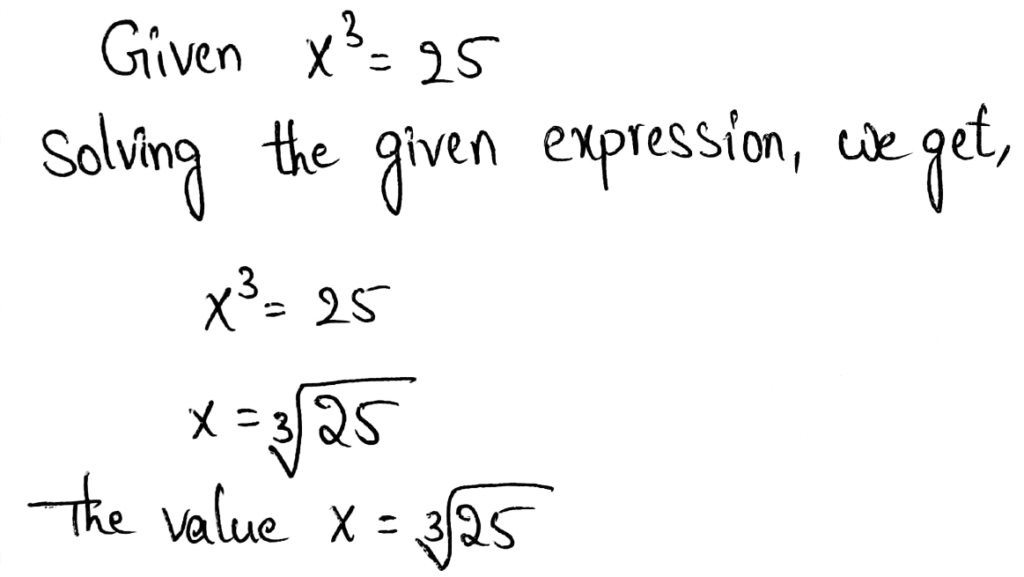
Envision Math Grade 8 Volume 1 Student Edition Answers Chapter 1 Real Number Topic 1 Page 76 Exercise 5 Answer
A container has a cube shape. It has a volume of 216 cubic inches. We need to find the dimensions of one face of the container.
The volume of a cube is given by, V = a3
where a is the dimension of one face of the container.

The dimensions of one face of the container is 6 inches.
Envision Math Grade 8 Volume 1 Student Edition Answers Chapter 1 Real Number Topic 1 Page 76 Exercise 2 Answer
We need to use the properties of exponents to write an equivalent expression for a given expression (36)−2
The power of powers property implies multiplying the powers to find the power of powers.
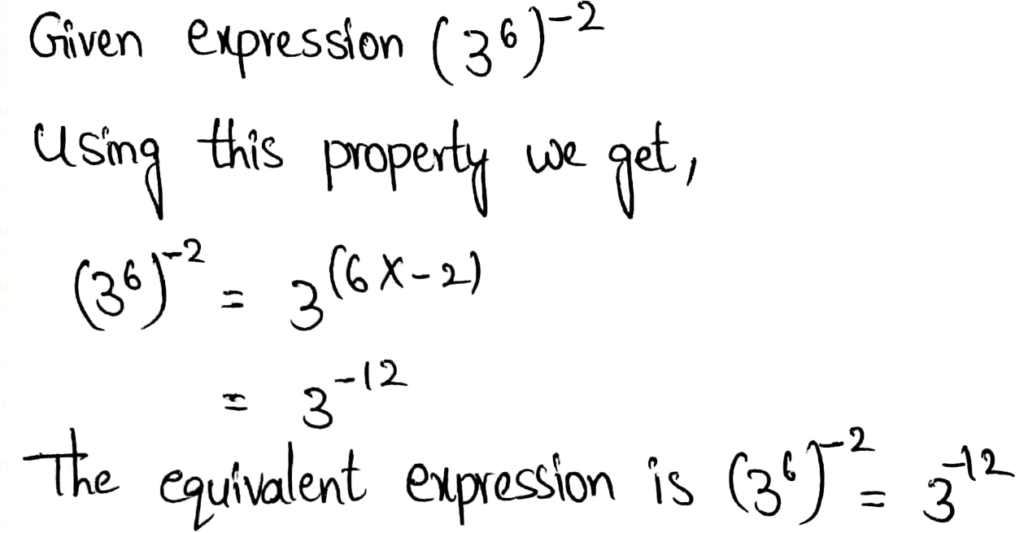
The equivalent expression is (36)−2 = 3−12
Envision Math Grade 8 Volume 1 Student Edition Answers Chapter 1 Real Number Topic 1 Page 76 Exercise 3 Answer
We need to use the properties of exponents to write an equivalent expression for a given expression 73 ⋅ 23
The power of product property implies multiplying the bases when the exponents are the same.
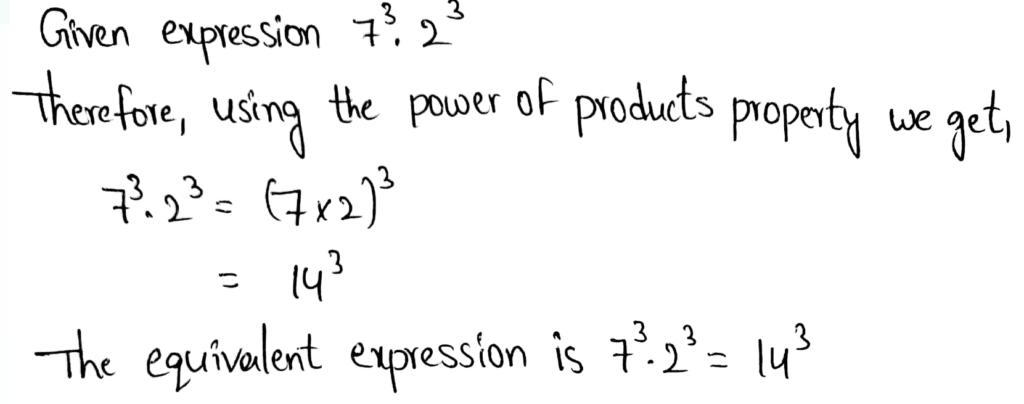
The equivalent expression is 73 ⋅ 23 = 143
Envision Math Grade 8 Volume 1 Student Edition Answers Chapter 1 Real Number Topic 1 Page 77 Exercise 1 Answer
We need to rewrite the expression using a positive exponent.
The given expression is 9−4
The negative exponent property states that when the exponent is negative, we need to put the number as a denominator in a fraction by changing the exponent into positive.

Rewriting the expression using a positive exponent, we get, \(9^{-4}=\frac{1}{9^4}\)
Real Number Topic 1 Essential Questions Guide Envisionmath Grade 8
Envision Math Grade 8 Volume 1 Student Edition Answers Chapter 1 Real Number Topic 1 Page 77 Exercise 3 Answer
We need to evaluate the expression for x = 2 and y = 5
The given expression is −4x−2 + 3y0
Given, −4x−2 + 3y0
Evaluating this using the zero exponent’s property and the negative exponent’s property, we get,
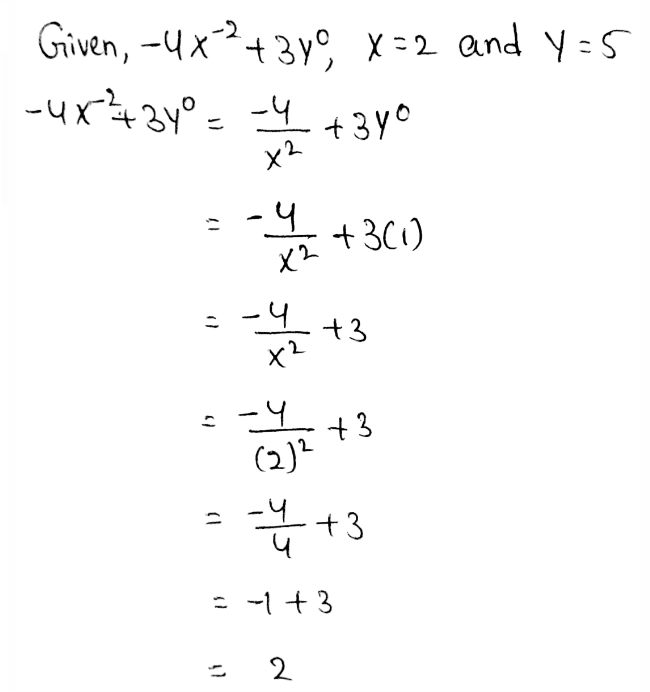
The value of −4x−2 + 3y0
Envision Math Grade 8 Volume 1 Student Edition Answers Chapter 1 Real Number Topic 1 Page 77 Exercise 4 Answer
We need to evaluate the expression for x = 2 and y = 5
The given expression is 2x0y−2
Given, 2x0y−2
Evaluating this using the zero exponent’s property and the negative exponent’s property, we get,

The value of \(2 x^0 y^{-2}=\frac{2}{25}\)
Envisionmath Grade 8 Volume 1 Chapter 1 Review Solutions
Envision Math Grade 8 Volume 1 Student Edition Answers Chapter 1 Real Number Topic 1 Page 77 Exercise 1 Answer
Given that, In the year 2013 the population of California was about 38,332,521 people. We need to write the estimated population as a single digit times a power of 10.
Rounded to the greatest place value, we get,
38,332,521 = 40,000,000
There are 7 zeros in the rounded number.
Thus, the value will be,
40,000,000= 4 × 107
The exponent is positive since the given number is greater than one.
The given value is written as a single digit times a power of ten, the estimate is 4 × 107
Envision Math Grade 8 Volume 1 Student Edition Answers Chapter 1 Real Number Topic 1 Page 77 Exercise 2 Answer
Given that the wavelength of green light is about 0.00000051 meter. We need to find the estimated wavelength as a single digit times a power of 10.
Rounded to the greatest place value, we get,
0.00000051 = 0.0000005
There are 7 zeros in the rounded number.
Thus, the value will be,
0.0000005 = 5 × 10-7
The exponent is negative since the given number is less than one.
The given value is written as a single digit times a power of ten, the estimate is 5 × 10-7
Envision Math Grade 8 Volume 1 Student Edition Answers Chapter 1 Real Number Topic 1 Page 78 Exercise 1 Answer
We need to write 803,000,000 in scientific notation.
The number in scientific notation will have two factors.
The first factor will have values between one and ten.
The second factor will be the power of ten.
Here, the given number is 803,000,000
The given number in scientific notation will be,
803,000,000 = 8.03 × 108
The given number in scientific notation will be,803,000,000 = 8.03 × 108
Envisionmath 2.0 Grade 8 Chapter 1 Real Number Practice Problems
Envision Math Grade 8 Volume 1 Student Edition Answers Chapter 1 Real Number Topic 1 Page 78 Exercise 2 Answer
We need to write 0.0000000068 in scientific notation.
The number in scientific notation will have two factors.
The first factor will have values between one and ten.
The second factor will be the power of ten.
Here, the given number is 0.0000000068
The given number in scientific notation will be,0.0000000068 = 6.8 × 10-9
Negative exponents are used since the given number is very small.
The given number in scientific notation will be,0.0000000068 = 6.8 × 10-9
Envision Math Grade 8 Volume 1 Student Edition Answers Chapter 1 Real Number Topic 1 Page 78 Exercise 3 Answer
We need to write the answer to the given operation in scientific notation.
(4.1 × 104) + (5.6 × 106)
Performing the given addition, we get,
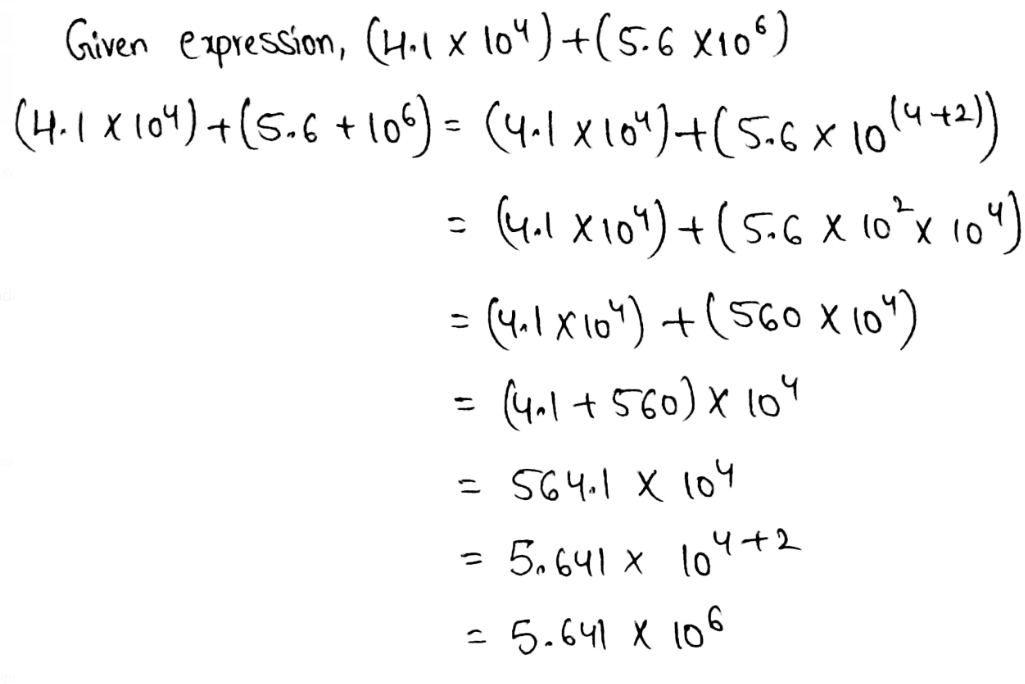
The value of (4.1 × 104) + (5.6 × 106) in scientific notation is 5.641 × 106
How To Solve Real Number Problems In Envisionmath Grade 8
Envision Math Grade 8 Volume 1 Student Edition Answers Chapter 1 Real Number Topic 1 Page 78 Exercise 4 Answer
Given that the population of Town A is 1.26 × 105 people. The population of Town B is 2.8 × 104 people. We need to know how many times greater is the population of Town A than the population of Town B.
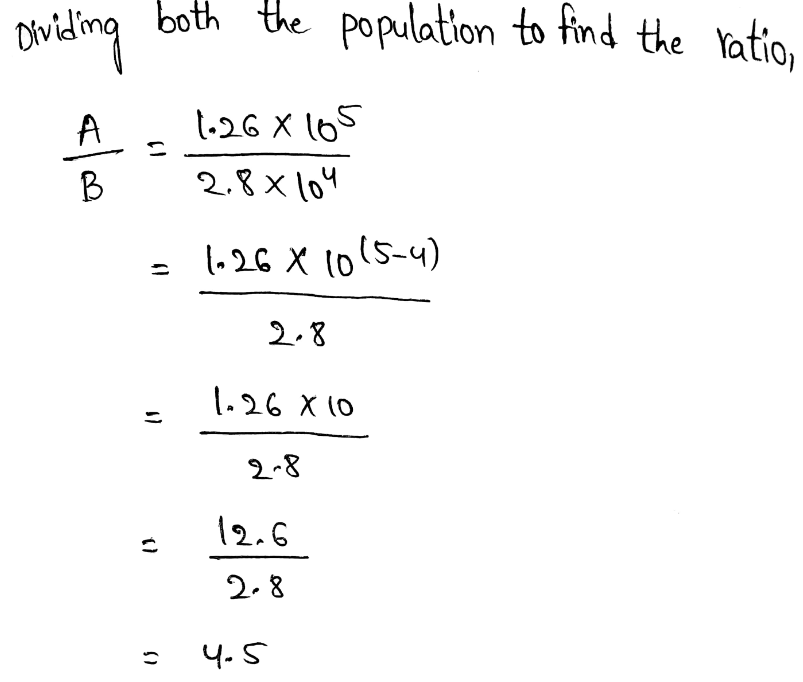
4.5 times greater is the population of Town A than the population of Town B.
